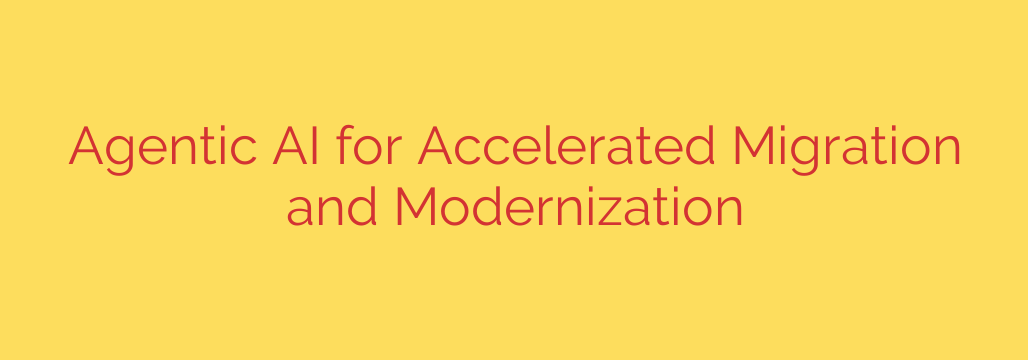
Supercharge Your Modernization: How Agentic AI Is Breaking Down Legacy Barriers
For decades, legacy systems have been the silent anchors holding businesses back. Written in aging languages like COBOL and built on monolithic architectures, these critical systems are often reliable but incredibly difficult to update, scale, or integrate with modern technology. The process of migrating or modernizing them is notoriously slow, expensive, and fraught with risk. Until now.
A groundbreaking approach is fundamentally changing the landscape of digital transformation: Agentic AI. This isn’t just another language model; it’s a sophisticated system of autonomous AI “agents” that can reason, plan, and collaborate to tackle complex software engineering tasks with unprecedented speed and accuracy. By leveraging Agentic AI, organizations can finally overcome the hurdles of modernization and unlock new levels of innovation.
The Modernization Dilemma: Trapped by Technical Debt
Most organizations understand the urgent need to modernize. Legacy systems create significant challenges, including:
- Crippling Technical Debt: Maintaining outdated codebases consumes vast resources that could be spent on innovation.
- A Widening Skills Gap: Finding developers with expertise in languages like COBOL is increasingly difficult and expensive.
- Security Vulnerabilities: Older platforms often lack modern security protocols, exposing the business to significant risk.
- Inability to Innovate: Monolithic systems can’t support the agile, scalable, and data-driven applications required to compete today.
Traditional modernization efforts often involve massive teams of developers spending years manually analyzing and rewriting millions of lines of code, a process so daunting that many projects fail before they even begin.
What Makes Agentic AI a Game-Changer?
Think of Agentic AI not as a single tool, but as a coordinated team of AI specialists. Each agent has a specific role—analyst, architect, coder, tester—and they work together to deconstruct and rebuild complex applications. This is possible because these agents can:
- Analyze and Reason: They can ingest an entire legacy codebase, understand its business logic, identify dependencies, and map out its architecture.
- Plan Complex Tasks: Based on the analysis, the agents create a detailed, multi-step plan for modernization, from code conversion to cloud deployment.
- Utilize Tools: The agents can operate development tools, compilers, and testing frameworks to execute the plan autonomously.
- Self-Correct: If a piece of generated code fails a test, the system can identify the error, reason about the cause, and rewrite the code until it passes.
This autonomous, collaborative capability is what allows Agentic AI to drastically accelerate timelines while minimizing human error.
The Four Pillars of AI-Accelerated Modernization
The power of Agentic AI becomes clear when you look at how it transforms each stage of a modernization project.
1. Automated Discovery and Analysis
Before you can modernize a system, you have to understand it completely. This discovery phase often takes months of manual effort. An AI agent acts like a digital archaeologist, automatically scanning the entire legacy application to create a comprehensive blueprint. It maps every data model, service dependency, and API endpoint, providing a clear picture of the existing architecture and identifying potential refactoring opportunities.
2. Intelligent Code Transformation and Refactoring
This is where the magic happens. Agentic AI can translate legacy code (like COBOL or old Java versions) into modern, high-quality languages like Java or Python. Critically, it doesn’t just do a line-by-line translation. It understands the underlying business logic and refactors the code to fit modern architectural patterns, such as breaking a monolith down into efficient microservices. The resulting code is clean, maintainable, and well-documented.
3. Comprehensive and Automated Test Generation
One of the biggest risks in any migration is ensuring the new system functions identically to the old one. Agentic AI addresses this head-on by automatically generating a full suite of unit and integration tests. By analyzing the original system’s behavior, it creates tests that verify the new code’s correctness, ensuring functional parity and dramatically reducing the risk of post-launch bugs.
4. Optimized Cloud Deployment and Integration
The final step is moving the modernized application to the cloud. Agentic AI can automate the creation of deployment configurations (like Docker files and Kubernetes manifests), ensuring the new application is deployed efficiently and correctly in cloud environments like AWS or Azure. This ensures the system is not only modern in its code but also in its operation—scalable, resilient, and cost-effective.
Key Benefits of an Agentic AI Approach
Adopting Agentic AI for your modernization initiatives delivers powerful and tangible business outcomes:
- Drastically Reduced Timelines: Projects that would typically take years can now be completed in a matter of months.
- Significant Cost Savings: Automation reduces the reliance on large, specialized development teams, cutting down on labor costs and resource allocation.
- Minimized Project Risk: Automated code analysis and comprehensive test generation catch issues early, preventing costly failures and ensuring a smooth transition.
- Bridging the Talent Gap: By automating the conversion of legacy code, organizations are no longer dependent on a shrinking pool of specialized developers.
Is Your Organization Ready for AI-Powered Modernization?
If your business relies on critical legacy systems, the question is no longer if you should modernize, but how. Agentic AI presents a clear and powerful path forward. To get started, consider these steps:
- Identify a Target Application: Begin with a critical but manageable legacy system to serve as a pilot project.
- Define Clear Business Outcomes: Focus on what you want to achieve—greater agility, lower operating costs, or enhanced security.
- Explore a Phased Approach: Use Agentic AI to first analyze your system and provide a clear modernization roadmap before committing to a full-scale transformation.
The era of multi-year, high-risk modernization projects is ending. With Agentic AI, businesses can finally break free from the constraints of their legacy technology and build a foundation for future growth and innovation.
Source: https://azure.microsoft.com/en-us/blog/accelerate-migration-and-modernization-with-agentic-ai/








